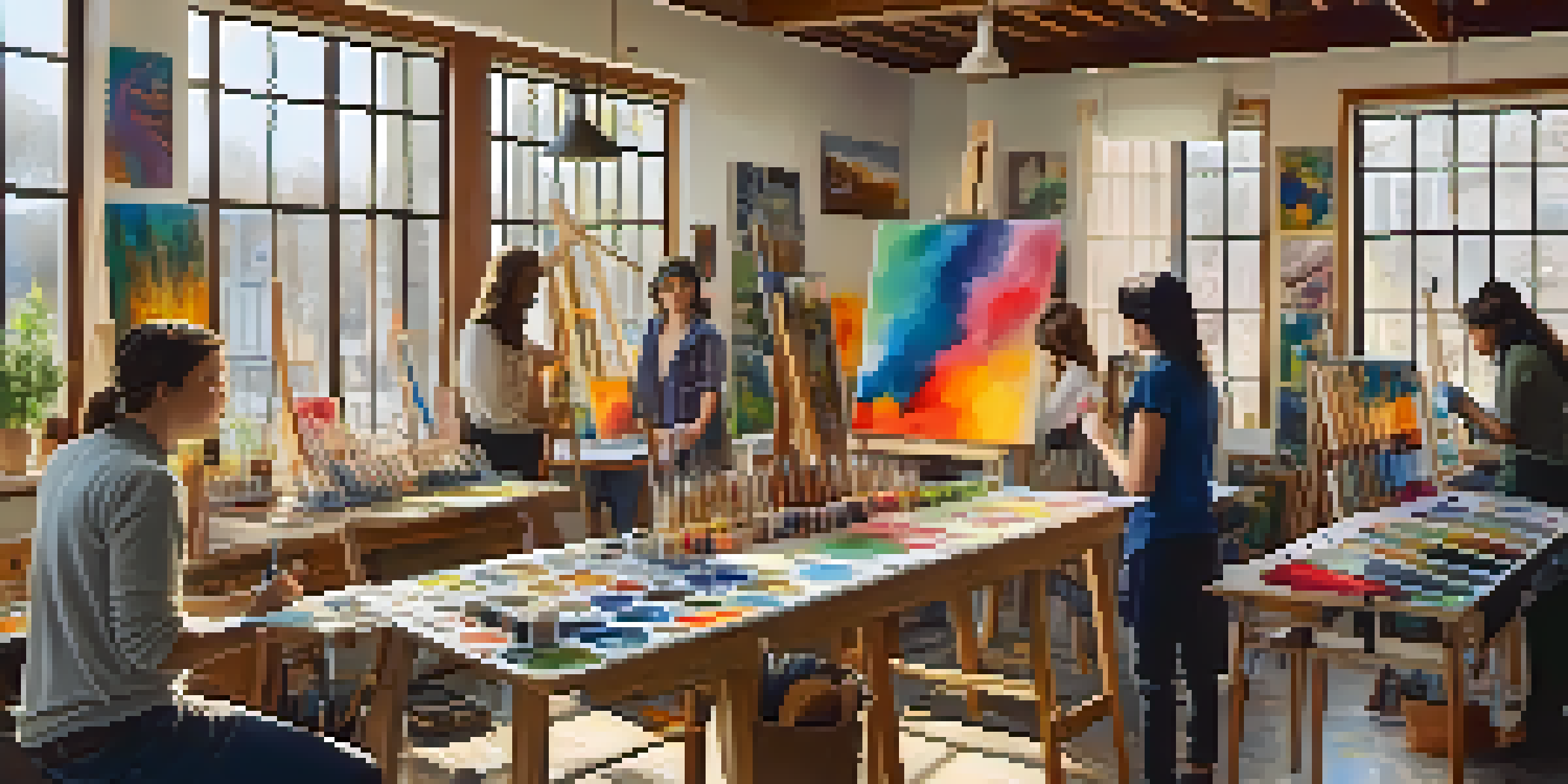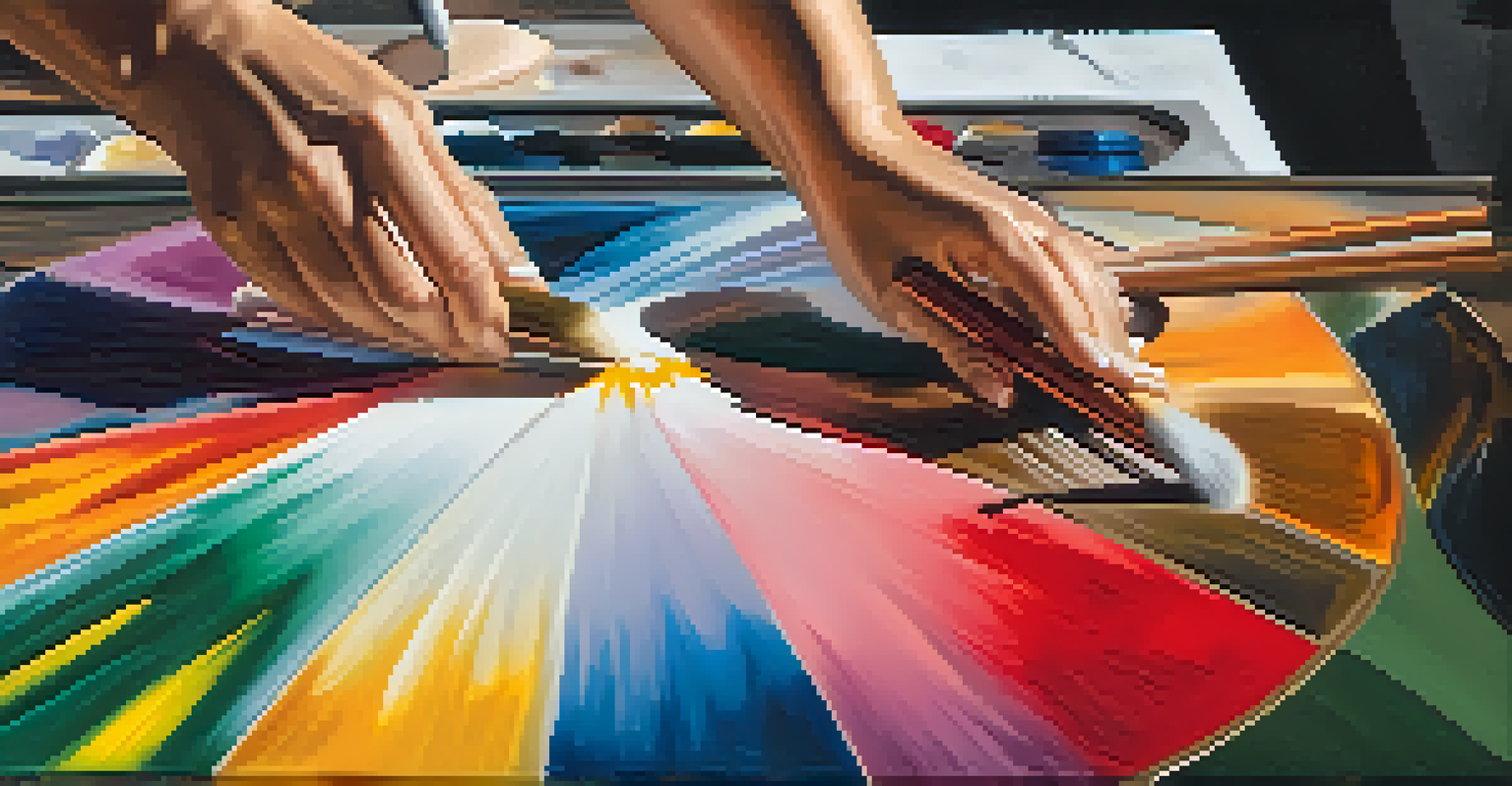Art Schools: Nurturing the Next Generation of Painters

The Role of Art Schools in Artistic Development
Art schools play a crucial role in shaping the skills and creative vision of aspiring painters. They provide structured environments where students can explore various techniques and mediums, ranging from oil and acrylic to watercolor and mixed media. Through guided instruction, students learn not just the basics of painting but also how to develop their unique style.
Art is not freedom from discipline, but disciplined freedom.
Moreover, these institutions often emphasize the importance of art theory and history, helping students understand the context behind their work. This foundational knowledge enriches their perspective, enabling them to connect with the art world on a deeper level. The blend of practical skills and theoretical understanding is essential for any budding artist.
In essence, art schools serve as incubators for creativity, fostering an atmosphere where experimentation is encouraged. This freedom allows students to push boundaries and discover their artistic voice, setting the stage for future success in the art community.
The Importance of Mentorship in Art Education
Mentorship is a cornerstone of art education, and art schools often provide access to experienced instructors who can guide students on their artistic journey. These mentors offer personalized feedback, helping students refine their techniques and overcome creative blocks. The one-on-one attention can significantly enhance a student's growth and confidence.

In addition to technical guidance, mentors share invaluable insights into the art industry. They can offer advice on how to navigate the competitive landscape, from networking opportunities to exhibition strategies. Such knowledge is often gained only through years of experience, making it a priceless asset for aspiring painters.
Art Schools Foster Creative Skills
Art schools provide structured environments for students to explore various techniques, develop their unique styles, and gain a deeper understanding of art theory and history.
Beyond the classroom, mentorship fosters lasting relationships that can extend into professional life. Many successful artists credit their mentors for providing the support and encouragement needed to thrive, demonstrating the powerful impact of these connections within art schools.
Diversity in Artistic Expression at Art Schools
Art schools celebrate diversity by welcoming students from various backgrounds and cultures. This rich tapestry of experiences contributes to a vibrant learning environment where different perspectives can flourish. Engaging with peers from diverse backgrounds can inspire fresh ideas and innovative approaches to painting.
Every artist was first an amateur.
Moreover, many art schools prioritize inclusivity in their curriculum, encouraging students to explore themes related to identity, culture, and social issues. This focus allows young artists to address relevant topics through their work, enhancing their personal narratives and making their art more impactful. For instance, a student might explore their heritage through a series of paintings that tell their family's story.
Ultimately, embracing diversity not only enriches the educational experience but also prepares students for an increasingly global art market. Understanding various cultural contexts can help artists resonate with a broader audience, making their art more relevant and relatable.
Hands-On Experience: Learning Beyond the Classroom
Art schools emphasize the importance of hands-on experience through workshops, studio time, and collaborative projects. Such opportunities allow students to apply what they've learned in the classroom to real-world scenarios, enhancing their practical skills. It's one thing to learn about techniques; it's another to execute them in a supportive environment.
Many institutions also facilitate community engagement by organizing exhibitions and public art projects. These experiences not only build students' portfolios but also foster connections with the local art scene. For instance, showcasing work in a gallery can provide invaluable exposure and help students learn how to present their art professionally.
Mentorship Enhances Artistic Growth
Access to experienced mentors in art schools offers personalized feedback and invaluable industry insights, significantly boosting students' confidence and skills.
Furthermore, hands-on experiences teach students resilience and adaptability, crucial traits for any artist. Navigating challenges in their projects prepares them for the inevitable ups and downs of a professional art career, equipping them with the tools to succeed.
Building a Strong Artistic Portfolio
A strong portfolio is essential for any aspiring painter, and art schools provide guidance on how to create one that showcases individual talent. Students learn to curate their works, selecting pieces that best represent their style and abilities. This process encourages self-reflection and helps them understand their artistic identity.
Instructors often emphasize the importance of versatility within a portfolio, encouraging students to include a range of techniques and subjects. This diversity not only highlights their skills but also demonstrates their adaptability, making them more appealing to potential galleries or clients. For example, a student might include everything from abstract pieces to realistic portraits.
Moreover, art schools often host portfolio reviews, giving students the opportunity to receive constructive feedback from peers and professionals. This collaborative atmosphere fosters growth and instills confidence, preparing them for future opportunities in the art world.
Networking Opportunities within Art Schools
Networking is an invaluable aspect of an artist's career, and art schools facilitate connections among students, faculty, and industry professionals. Through workshops, guest lectures, and networking events, students have the chance to meet established artists and art critics who can influence their careers. These interactions often lead to mentorship opportunities and collaborations.
Additionally, art schools may partner with galleries and art organizations to provide students with internship opportunities. These experiences allow students to gain hands-on experience in the art world, helping them build connections that can last a lifetime. It's not uncommon for students to land internships that turn into full-time positions after graduation.
Exhibitions Boost Student Visibility
Participating in exhibitions allows art students to showcase their work, gain confidence, and open doors to future opportunities in their artistic careers.
Creating a network during their studies equips students with the resources and connections needed to launch their careers. As they transition into the professional realm, these relationships can prove crucial in navigating exhibitions, commissions, and art fairs.
The Value of Exhibitions and Showcases
Exhibitions and showcases are vital for art students as they provide a platform to display their work to the public. Art schools often organize events that allow students to present their creations to peers, faculty, and the community. These events not only celebrate students' achievements but also help them gain confidence in their artistic abilities.
Participating in exhibitions teaches students how to present their work professionally, from framing and hanging art to writing artist statements. These skills are essential for any artist looking to make an impact in the art world. For example, a well-crafted artist statement can provide context for their work and engage viewers more deeply.

Moreover, showcasing their art can lead to opportunities for sales, commissions, or recognition from galleries. Many artists have launched successful careers after participating in exhibitions during their studies, illustrating the importance of these experiences in their artistic journey.